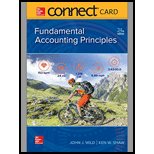
Concept explainers
Concept Introduction:
Current assets are Assets of the business that are realizable or convertible to cash within a period of one year or less.
Examples of Current assets include Stocks and Inventories, Debtors and Investments made for a period of less than one year.
Inventories refer to the closing balance of stock of raw materials, work in progress and finished goods of a company at the end of a particular reporting period.
Requirement 1:
Inventories reported by Apple on September 30, 2017 and September 24,2016.
Concept Introduction:
Current assets are Assets of the business that are realizable or convertible to cash within a period of one year or less.
Examples of Current assets include Stocks and Inventories, Debtors and Investments made for a period of less than one year.
Inventories refer to the closing balance of stock of raw materials, work in progress and finished goods of a company at the end of a particular reporting period.
Requirement 2:
Inventories reported by Apple on September 30, 2017 and September 24,2016 as a percentage of Current Assets.
Concept Introduction:
Current assets are Assets of the business that are realizable or convertible to cash within a period of one year or less.
Examples of Current assets include Stocks and Inventories, Debtors and Investments made for a period of less than one year.
Inventories refer to the closing balance of stock of raw materials, work in progress and finished goods of a company at the end of a particular reporting period.
Requirement 3:
If Apple would prefer to have inventories as a lower or higher percentage of current assets.
Concept Introduction:
Ratio Analysis:
Ratio analysis is a study of several key metrics of a company based on the data presented in its' financial statements with an objective to evaluate the financial health of a company.
It is essential for investors, stakeholders, government bodies etc. to evaluate the key metrics of an entity in order to ensure that the company fulfills the going concern principle and displays financial stability.
Inventory turnover − A measure of the relation between the turnover and inventory measured in number of times.
It seeks to measure the relation of the inventory rolled over in proportion to the total turnover and is an indicator of how much of the inventory is fast moving in relation to the total turnover.
Days Sale in Inventory − A measure of the total outstanding collections for credit sales in terms of inventory.
It is calculated to understand how many days sales in terms of inventory are available to the company.
Requirement 4:
Inventory Turnover Ratio and Days Sale in Inventory as on 30 September, 2017
Trending nowThis is a popular solution!

Chapter 6 Solutions
Connect Access Card For Fundamental Accounting Principles
- I need help with this financial accounting question using standard accounting techniques.arrow_forwardCould you help me solve this financial accounting question using appropriate calculation techniques?arrow_forwardI am searching for the correct answer to this financial accounting problem with proper accounting rules.arrow_forward

 AccountingAccountingISBN:9781337272094Author:WARREN, Carl S., Reeve, James M., Duchac, Jonathan E.Publisher:Cengage Learning,
AccountingAccountingISBN:9781337272094Author:WARREN, Carl S., Reeve, James M., Duchac, Jonathan E.Publisher:Cengage Learning, Accounting Information SystemsAccountingISBN:9781337619202Author:Hall, James A.Publisher:Cengage Learning,
Accounting Information SystemsAccountingISBN:9781337619202Author:Hall, James A.Publisher:Cengage Learning, Horngren's Cost Accounting: A Managerial Emphasis...AccountingISBN:9780134475585Author:Srikant M. Datar, Madhav V. RajanPublisher:PEARSON
Horngren's Cost Accounting: A Managerial Emphasis...AccountingISBN:9780134475585Author:Srikant M. Datar, Madhav V. RajanPublisher:PEARSON Intermediate AccountingAccountingISBN:9781259722660Author:J. David Spiceland, Mark W. Nelson, Wayne M ThomasPublisher:McGraw-Hill Education
Intermediate AccountingAccountingISBN:9781259722660Author:J. David Spiceland, Mark W. Nelson, Wayne M ThomasPublisher:McGraw-Hill Education Financial and Managerial AccountingAccountingISBN:9781259726705Author:John J Wild, Ken W. Shaw, Barbara Chiappetta Fundamental Accounting PrinciplesPublisher:McGraw-Hill Education
Financial and Managerial AccountingAccountingISBN:9781259726705Author:John J Wild, Ken W. Shaw, Barbara Chiappetta Fundamental Accounting PrinciplesPublisher:McGraw-Hill Education





